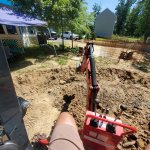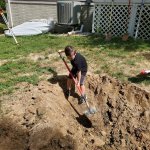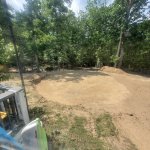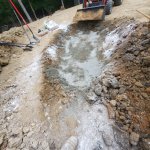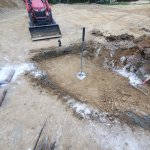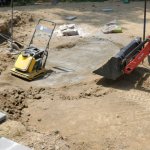Well beside from my intro post this is my first post here. We (wife) picked up a 27' resin pool and I spend the last few days leveling our off grade back yard. LOTS of dirt. But.. I am level within 1" except for a few areas that are spongy that have revealed themselves (everything is trash clay backfill). So this weekend will be spent dealing with this new roadblock or pool block. Hopefully I can dig some out and mix in lime and some mortar mix and gravel let it sit and refill and compact to get it to solidify if not I don't know what to do. wish me luck.
27 foot of...
- Thread starter Zaphod07
- Start date
You are using an out of date browser. It may not display this or other websites correctly.
You should upgrade or use an alternative browser.
You should upgrade or use an alternative browser.
- Jun 22, 2014
- 47,790
- Pool Size
- 17888
- Surface
- Fiberglass
- Chlorine
- Salt Water Generator
- SWG Type
- CircuPool RJ-45 Plus
Love the child labor! That needs to happen more often so they have ownership in their lives! Good parenting there!!
Spongy spots/trashy clay. How spongy? How deep is it? Sounds like you have a plan to take care of it. I am also going to remind anyone reading this that pools should be put on solid, undisturbed ground to protect from the weight of the pool causing it to sink down and becoming unlevel. That is my public service announcement for this subject.
Spongy spots/trashy clay. How spongy? How deep is it? Sounds like you have a plan to take care of it. I am also going to remind anyone reading this that pools should be put on solid, undisturbed ground to protect from the weight of the pool causing it to sink down and becoming unlevel. That is my public service announcement for this subject.
I couldn't stop him if I wanted to that boy is 100% determination. the ground is mostly rock hard so he was not making a dent... untill he figured he could use a mini sledge and hammer the shovel in.Love the child labor! That needs to happen more often so they have ownership in their lives! Good parenting there!!
Spongy spots/trashy clay. How spongy? How deep is it? Sounds like you have a plan to take care of it. I am also going to remind anyone reading this that pools should be put on solid, undisturbed ground to protect from the weight of the pool causing it to sink down and becoming unlevel. That is my public service announcement for this subject.
Pretty spongy, I bed the ground deflects 3/4 to an 1 inch and I have no clue as to how far down i will have to go to get decent ground yet. But i have already excavated down 25" on the high side to get a level grade without backfilling. the "crust" was pretty solid down to that point.
LOVE IT! Tell him this is what he made me think of with his sledge hammer!I couldn't stop him if I wanted to that boy is 100% determination. the ground is mostly rock hard so he was not making a dent... untill he figured he could use a mini sledge and hammer the shovel in.

DefinitelyLOVE IT! Tell him this is what he made me think of with his sledge hammer!

Well tonight I was able to dig out the one of the effected areas about 12" deep 4ft wide 8 ft long pit of trash clay, roots limbs and a aluminum can. The Massey back hoe attachment basically sank into the area with little resistance. I went down till there was some substance to the clay. So now what am I doing to remedy the spot. Well I started with a generous layer of lime powder (supposed to help dry up any residual moisture) then started layering fresh dry soil 1". Throughly tamping solid then a light misting with the hose. Then spreading morter dust and repeat. I have got about 4 layers doing this down before it was dark. And the ground is solid so far with 0 give. Finish this spot off tomorrow and move onto the next spot which I think will be smaller. Hopefully......
Attachments
Day 2 of fixing the bad spots. Got the wife out to help. My hands and arms were pretty dead and at the start the wife was all "let me help tamp, its not that bad" after a hour and half of hand tamping I re-suggested that a plate compactor was not a terrible expense that was enthusiasticly agreed upon. (She had to see for herself). So off to True value and hole 1 was done in reasonable time. Area 2 was alot smaller as i expected and filled pretty quick with the same dirt, morter dust layer sequence.....but I was cut short by what I would guess was 1 bucket because we got hit with some rain and tomorrow's forecast calls for rain. So we will see how it all settles out.. Monday after it get time to dry out.
Attachments
Proud of her for lasting that long! Our shoulders are not made for that. She did GOOD!at the start the wife was all "let me help tamp, its not that bad" after a hour and half of hand tamping I re-suggested that a plate compactor was not a terrible expense that was enthusiasticly agreed upon.
She will learn the value of having a machine to do the work if at all possible! OH there is a tool/machine for that? Let me go pick it up for you!! LOL(She had to see for herself).
phonedave
Well-known member
- May 30, 2012
- 1,944
- Pool Size
- 17000
- Surface
- Vinyl
- Chlorine
- Salt Water Generator
- SWG Type
- Hayward Turbo Cell (T-CELL-5)
Just because, here is my standard PSA on soil compaction
You cannot just "put in dirt and compact it really well" even if you are using the correct fill material, you cannot just "compact it really well". Soils have a optimal moisture content (percentage) where they will compact to their maximum dry density. If you have more or less water in the soil, you can compact it until the cows come home and it will never reach its maximum potential density. Then 2 years down the road when it dries out some, or it rains and it gets a little wetter, with your pool sitting on it, it compacts some more. No bueno.
Some soils are more forgiving than others. The goal in construction (most of the time) is to reach 95% of the maximum dry density. Some soils have a flatter curve. What that means is that if your moisture content is between say 4% and 9% you can still hit that 95% compaction. Other are really sharp, and if you are more than a 1% off you will never reach 95% compaction.
So how do you know these curves and measure the compaction? You hire a geotechnical engineer (sorry, I left that field a long time ago and no longer do site inspections). They run compaction curves (Proctor tests) in the lab and then measure the in place density in the field.
Now we come to point #2. Isn't that a lot of overkill you say? I'm building a pool, not a garage. Ahh, there is the difference. A pool is HEAVY. More psi loading than a garage. Also, a garage on a slab is much more rigid, and is able to bridge minor variations in the substrate. An ABG is a big flexible bag of water with almost no structural rigidity. If something starts to settle, the whole bag o' water is going in that direction, with disastrous results.
Now, you are doing 1" lifts, which is a good start. Hand compaction is next to useless. Plate compactors depend on the unit itself. If you don't need your machine to lift it out of your pickup/trailer it likely is not enough.
You said you added lime. Lime is not lime is not lime. Quicklime, hydraded lime, and hydraulic lime are all different, behave in different ways, and have different properties when it come to ground modification. They should also be worked into the soil, with something like a sheepsfoot roller, not sprinkled on top. If you are trying to compact clayey soils, a sheepfoot roller is your best option actually. Plates and smooth drums are a distant second.
You also mention mortar dust. Are you just adding bags of mortar to the ground? Again, like sand, mortar is not mortar But, all mortar is sand, cement, and hydrated lime. It is just the ratios that make it different. You are not getting any strength from the cement by sprinkling it on. It is too thin a layer, and doubt it has hydrated properly. You would have to be adding a lot of mortar mix to make any difference
You cannot just "put in dirt and compact it really well" even if you are using the correct fill material, you cannot just "compact it really well". Soils have a optimal moisture content (percentage) where they will compact to their maximum dry density. If you have more or less water in the soil, you can compact it until the cows come home and it will never reach its maximum potential density. Then 2 years down the road when it dries out some, or it rains and it gets a little wetter, with your pool sitting on it, it compacts some more. No bueno.
Some soils are more forgiving than others. The goal in construction (most of the time) is to reach 95% of the maximum dry density. Some soils have a flatter curve. What that means is that if your moisture content is between say 4% and 9% you can still hit that 95% compaction. Other are really sharp, and if you are more than a 1% off you will never reach 95% compaction.
So how do you know these curves and measure the compaction? You hire a geotechnical engineer (sorry, I left that field a long time ago and no longer do site inspections). They run compaction curves (Proctor tests) in the lab and then measure the in place density in the field.
Now we come to point #2. Isn't that a lot of overkill you say? I'm building a pool, not a garage. Ahh, there is the difference. A pool is HEAVY. More psi loading than a garage. Also, a garage on a slab is much more rigid, and is able to bridge minor variations in the substrate. An ABG is a big flexible bag of water with almost no structural rigidity. If something starts to settle, the whole bag o' water is going in that direction, with disastrous results.
Now, you are doing 1" lifts, which is a good start. Hand compaction is next to useless. Plate compactors depend on the unit itself. If you don't need your machine to lift it out of your pickup/trailer it likely is not enough.
You said you added lime. Lime is not lime is not lime. Quicklime, hydraded lime, and hydraulic lime are all different, behave in different ways, and have different properties when it come to ground modification. They should also be worked into the soil, with something like a sheepsfoot roller, not sprinkled on top. If you are trying to compact clayey soils, a sheepfoot roller is your best option actually. Plates and smooth drums are a distant second.
You also mention mortar dust. Are you just adding bags of mortar to the ground? Again, like sand, mortar is not mortar But, all mortar is sand, cement, and hydrated lime. It is just the ratios that make it different. You are not getting any strength from the cement by sprinkling it on. It is too thin a layer, and doubt it has hydrated properly. You would have to be adding a lot of mortar mix to make any difference
Well that is all good to know but at this point in time I don't know what else to do. I can't afford or spare to dig the entire area down another 2+ foot.Just because, here is my standard PSA on soil compaction
You cannot just "put in dirt and compact it really well" even if you are using the correct fill material, you cannot just "compact it really well". Soils have a optimal moisture content (percentage) where they will compact to their maximum dry density. If you have more or less water in the soil, you can compact it until the cows come home and it will never reach its maximum potential density. Then 2 years down the road when it dries out some, or it rains and it gets a little wetter, with your pool sitting on it, it compacts some more. No bueno.
Some soils are more forgiving than others. The goal in construction (most of the time) is to reach 95% of the maximum dry density. Some soils have a flatter curve. What that means is that if your moisture content is between say 4% and 9% you can still hit that 95% compaction. Other are really sharp, and if you are more than a 1% off you will never reach 95% compaction.
So how do you know these curves and measure the compaction? You hire a geotechnical engineer (sorry, I left that field a long time ago and no longer do site inspections). They run compaction curves (Proctor tests) in the lab and then measure the in place density in the field.
Now we come to point #2. Isn't that a lot of overkill you say? I'm building a pool, not a garage. Ahh, there is the difference. A pool is HEAVY. More psi loading than a garage. Also, a garage on a slab is much more rigid, and is able to bridge minor variations in the substrate. An ABG is a big flexible bag of water with almost no structural rigidity. If something starts to settle, the whole bag o' water is going in that direction, with disastrous results.
Now, you are doing 1" lifts, which is a good start. Hand compaction is next to useless. Plate compactors depend on the unit itself. If you don't need your machine to lift it out of your pickup/trailer it likely is not enough.
You said you added lime. Lime is not lime is not lime. Quicklime, hydraded lime, and hydraulic lime are all different, behave in different ways, and have different properties when it come to ground modification. They should also be worked into the soil, with something like a sheepsfoot roller, not sprinkled on top. If you are trying to compact clayey soils, a sheepfoot roller is your best option actually. Plates and smooth drums are a distant second.
You also mention mortar dust. Are you just adding bags of mortar to the ground? Again, like sand, mortar is not mortar But, all mortar is sand, cement, and hydrated lime. It is just the ratios that make it different. You are not getting any strength from the cement by sprinkling it on. It is too thin a layer, and doubt it has hydrated properly. You would have to be adding a lot of mortar mix to make any difference
Well I have been in and out on travel but last week I got back to work on the pool and for the most part the filled area were holding up pretty good even after a ton of rain. But I missed some of the trash ground when I dug the first time and decided because of some of the replies and the missed soft ground to re-dig the holes and this time I filled with CR6 and compacted with my tractor with the bucket loaded for extra weight. Then filled the top 4" with "soil" dirt. And compacted that till it was rock hard. Now I am on travel again. And will pick up next week to fine tune the leveling.
Finally got a couple consecutive days of no rain, but it's frickin hot. No stopping the wife and I though, long sweaty afternoons and nights and everything is in, up and slowly filling with water. We are going to do the first 6k gallons with the hose ran through a inline filter and just because (the kids wanted to help make something) a polyfill bucket filter. Don't know it it will help but it surely can't hurt.
That's why I did mine. When I was done, the polyfll looked clean until I picked it up. Then iced tea drained from it so it definitely got something.Don't know it it will help but it surely can't hurt.
I just did a check and it's definitely catching stuff. The fill is getting black.
Thread Status
Hello , This thread has been inactive for over 60 days. New postings here are unlikely to be seen or responded to by other members. For better visibility, consider Starting A New Thread.


